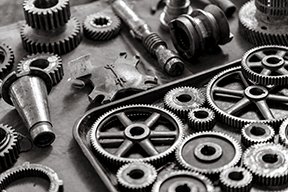Published: June 08, 2022 | Updated: October 06, 2025
Published: June 08, 2022 | Updated: October 06, 2025
The Hidden Costs of Clutter: Tackling Unused Inventory in Manufacturing
 Welcome to the third part of our series on stockroom challenges in the manufacturing sector. This discussion tackles a hidden cost of clutter: Unused inventory in manufacturing. These forgotten items occupy valuable space and represent tied-up capital, often in ways that are not immediately apparent. This article explores the various forms this waste can take within a manufacturing context and illustrates how a modern CMMS can provide the tools needed to identify and address this costly issue.
Welcome to the third part of our series on stockroom challenges in the manufacturing sector. This discussion tackles a hidden cost of clutter: Unused inventory in manufacturing. These forgotten items occupy valuable space and represent tied-up capital, often in ways that are not immediately apparent. This article explores the various forms this waste can take within a manufacturing context and illustrates how a modern CMMS can provide the tools needed to identify and address this costly issue.
The Lingering Legacy of Old Equipment
Consider a manufacturing plant that has upgraded its production line over the years. While the new machinery operates efficiently, remnants of the old equipment may still reside in the stockroom. These could be specialized parts, unique tools, or even entire sub-assemblies that are no longer compatible with the current systems. This obsolete inventory serves no practical purpose but occupies valuable storage space that could be used for active components. Without a systematic way to identify and remove these items, they continue to contribute to stockroom clutter and inefficiency.
The "Just in Case" Mentality
Another contributor to unused inventory is the tendency to hold onto parts with a "just in case" rationale. While a certain level of spare parts is essential, an overly cautious approach can lead to the accumulation of items that are rarely, if ever, needed. These low-usage parts sit on shelves for extended periods, tying up capital that could be invested elsewhere. Determining the appropriate levels requires careful analysis of equipment reliability and lead times, rather than simply erring on the side of overstocking.
The Mystery of Unidentified Components
In a busy manufacturing environment, parts can sometimes become separated from their original packaging or documentation. Over time, these unidentified components accumulate in the stockroom. Without a clear record of their purpose or the equipment they belong to, these stray items become essentially useless. The dilemma then arises: dispose of them and risk needing them later, or continue to store them indefinitely, adding to the clutter and making it more difficult to locate needed parts.
Tracking Usage with a CMMS
A significant advantage of implementing a CMMS in a manufacturing setting is its ability to track the usage of every inventory item. The system records when a part is issued for maintenance or repair, providing valuable data on its frequency of use. Reports generated by the CMMS can highlight parts that have not been used for an extended period, indicating potential obsolescence or overstocking. This approach allows for informed decisions regarding inventory disposal and future purchasing.
Deactivating Obsolete Inventory
When equipment is decommissioned or replaced, the corresponding parts/supplies in the stockroom become obsolete. A CMMS allows for the deactivation of these parts within the inventory system. This not only removes them from active inventory lists but also provides a clear record of items that can be safely disposed of. Furthermore, the CMMS can also track the status of the associated equipment, ensuring that parts for inactive machinery are not inadvertently reordered.
Establishing Equipment Hierarchies
Many manufacturing facilities utilize complex equipment with multiple interconnected components. A CMMS can establish equipment hierarchies, linking specific parts to the machines they belong to, and even to sub-assemblies within those machines. This hierarchical structure provides a clear understanding of which parts are associated with which equipment, eliminating the mystery of unidentified components. When a piece of equipment requires maintenance, technicians can quickly identify the correct part within the CMMS.
The Importance of Training
The successful utilization of a CMMS for managing unused inventory requires proper training for all personnel who will interact with the system. Understanding how to input data accurately, generate reports, and interpret the information provided is crucial. CMMS vendors typically offer training seminars to equip users with the necessary skills to leverage the system's features effectively. Investing in training ensures that the CMMS becomes a valuable tool for identifying and eliminating the hidden costs associated with unused inventory.
Addressing the challenge of unused inventory in manufacturing stockrooms requires a proactive approach. By leveraging the tracking and reporting capabilities of a CMMS, facilities can gain visibility into parts usage, identify obsolete items, and prevent the accumulation of unnecessary stock. This ultimately leads to a more efficient stockroom, reduced waste, and a healthier bottom line.
FAQs
What are the hidden costs of unused inventory in manufacturing?
Unused inventory ties up capital, wastes storage space, and adds clutter that reduces efficiency.
How does old equipment contribute to stockroom clutter?
Obsolete parts and tools from outdated machinery often remain stored, even though they no longer serve a purpose.
Why is the "just in case" mentality harmful to inventory management?
Overstocking rarely used parts locks up money and creates unnecessary clutter in the stockroom.
How can MAPCON’s CMMS help identify unused inventory?
MAPCON’s CMMS tracks parts usage and highlights items that haven’t been used for long periods, revealing waste.
What role do equipment hierarchies play in managing stockrooms?
Equipment hierarchies link parts to specific machines, reducing unidentified components and improving accuracy.
Why is training important when using a CMMS?
Proper training ensures staff use the system effectively, improving data accuracy and inventory management.
MAPCON | 800-922-4336
MAPCON CMMS software empowers you to plan and execute PM tasks flawlessly, thanks to its wealth of features and customizable options. Want to see it for yourself? Click the button below to get your FREE 30-day trial of MAPCON!
Try It FREE!